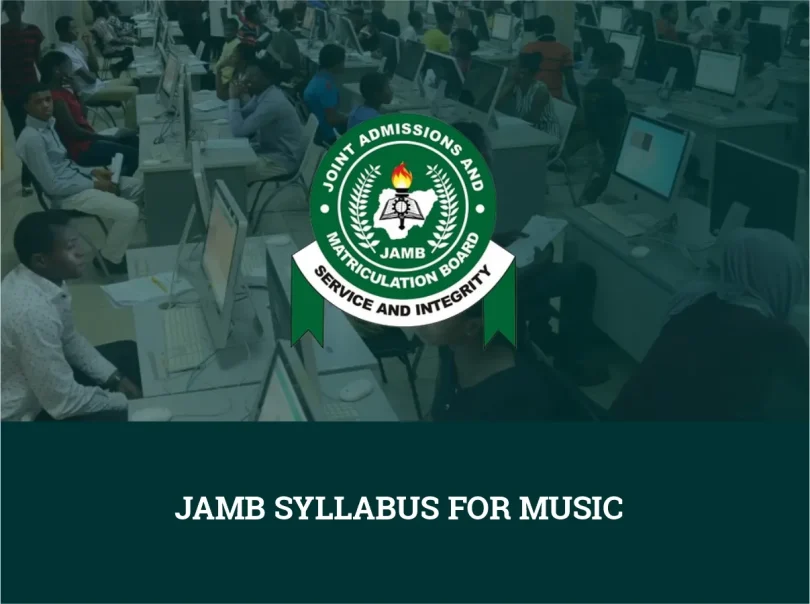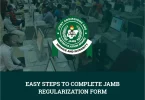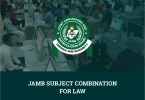Are you passionate about music and considering it as a subject for your JAMB examination? That is fantastic! Music is not just about listening; it is about understanding the elements that make it resonate with us. The JAMB Music syllabus is here to guide you through the essential topics you will need to grasp, from the basics of music theory.
Think of the JAMB syllabus for Music as your playlist for success in passing the examination, by concentrating on key topics such as musical notation, harmony, and the evolution of different musical genres brings you closer to passing the examination in one piece.
We urge candidates to read this article with much attention and concentration to get detailed information on the Rudiments of Music, Elementary Harmony, History and Literature of African Music, History and Literature of Western Music, and Comparative Music Studies. Information related to the examination structure and the recommended textbook, and resource material will be provided to keep fully abreast of the examination.
Outline of the JAMB Syllabus for Music
Here is a structured outline of the JAMB Music Syllabus, presented in a table format for clarity and ease of understanding. The JAMB Syllabus for Music is designed to guide candidates in their preparation for the Unified Tertiary Matriculation Examination (UTME) in Music.
Section A: Rudiments of Music
| Topic | Content | Objectives |
|---|---|---|
| 1. The Staff | – Great staff – Ledger lines and spaces – Open score (vocal score) – C clef (alto and tenor) | Identify all components of the staff and their applications. |
| 2. Music Notes and Rests | – Notes and rests with corresponding values | Determine the relative duration of different notes and rests. |
| 3. Time/Time Signature | – Simple and compound time signatures – Correct grouping of notes – Barring of unbarred passages | Interpret various rhythmic patterns in monotone. |
| 4. Key Signatures and Scales | – Diatonic major/minor (natural, harmonic, melodic) – Names of scale degrees – Determination of key (not exceeding two sharps/flats) | Identify simple scale passages with or without key signatures. |
| 5. Keyboard Settings and Enharmonic Equivalents | – White and black keys – Accidentals | Identify names of keys and their relationships (e.g., C♯ = D♭). |
| 6. Intervals | – Recognition of diatonic intervals and their inversions (e.g., perfect unison, 4th, 5th, 8th; major/minor 2nd, 3rd, 6th, 7th; diminished 5th; augmented 4th) | Determine different qualities of intervals (melodic and harmonic). |
| 7. Musical Terms and Expressions | – Definitions of simple musical terms, abbreviations, and expressions | Interpret simple musical terms. |
| 8. Transcription and Transposition | – Transcription between staff and tonic solfa notation – Transposition using treble (G) and bass (F) staves (not exceeding two sharps/flats) | Transcribe and transpose musical pieces accurately. |
Section B: Elementary Harmony
| Topic | Content | Objectives |
|---|---|---|
| 1. Triads and Inversions | – Primary and secondary triads in major keys (not exceeding two sharps/flats) – Chord indications using Roman numerals | Identify and compare types of triads; determine their use. |
| 2. Chord Progressions | – Basic chord progressions in four-part vocal style (SATB) – Dominant 7th chord in root position | Determine basic chord progressions in a music passage. |
| 3. Kinds of Motion | – Parallel, similar, contrary, and oblique motions | Identify various kinds of motion in a musical passage. |
| 4. Cadences | – Perfect, imperfect, plagal, and interrupted cadences in major keys (not exceeding two sharps/flats) | Identify various types of cadences in a musical score. |
| 5. Non-Harmonic Tones | – Neighbouring tones, passing tones, anticipation, acciaccatura, suspension, escape tones | Relate non-harmonic tones to associated chords. |
| 6. Modulation | – Simple diatonic modulations to closely related keys (dominant and subdominant) | Determine modulations in given melodies. |
| 7. Elementary Composition | – Setting words to written melodies – Recognition of suitable answers to musical phrases | Compose melodies that are compatible and balanced. |
Section C: History and Literature of African Music
| Topic | Content | Objectives |
|---|---|---|
| 1. Nigerian Folksongs | – Types, forms, and characteristics | Understand the diversity and features of Nigerian folksongs. |
| 2. Traditional Music and Arts | – Features and forms of Nigerian traditional music – Festivals, dances, and other arts | Appreciate the integration of music with other cultural expressions. |
| 3. Traditional Musical Instruments | – Classification and characteristics | Identify and classify Nigerian traditional musical instruments. |
| 4. African Traditional Musicians | – Lives and music of notable musicians, focusing on Nigerian artists | Recognize the contributions of traditional musicians to African music. |
| 5. Evolution of African Popular Music | – Development and characteristics | Trace the evolution and features of African popular music. |
| 6. African Popular Musicians | – Lives and music of prominent artists | Acknowledge the impact of African popular musicians. |
| 7. African Art Musicians | – Contributions to music | Understand the roles of African art musicians in music development. |
Section D: History and Literature of Western Music
| Topic | Content | Objectives |
|---|---|---|
| 1. Historical Development of Western Music Styles | – Periods: Medieval (800–1400), Renaissance (1400–1600), Baroque (1600–1750), Classical (1750–1820), Romantic (1820–1900) | Identify characteristics and developments of Western music periods. |
| 2. Composers | – Notable composers from each period | Recognize significant composers and their contributions. |
| 3. Music Forms and Media | – Various forms and mediums used in Western music | Understand different forms and media in Western music history. |
Section E: Comparative Music Studies
| Topic | Content | Objectives |
|---|---|---|
| 1. Black Musicians in the Diaspora | – Overview of composers and performers such as Mighty Sparrow, James Brown, Bob Marley, Michael Jackson, Stevie Wonder, and others | Appreciate the contributions of black musicians globally. |
| 2. Musical Forms | – Spirituals, gospel, jazz, rhythm and blues, soul, calypso, rock ‘n’ roll, reggae, afrobeat, tango, rap, chachacha, bolero, twist, hip-hop | Identify and differentiate various musical forms. |
| 3. Nationalism in Nigerian Music | – Spirit and expression of nationalism through music | Understand how music reflects and promotes national identity. |
Examination Structure
The JAMB Music examination is structured to assess candidates’ understanding and appreciation of music across various domains. The exam typically comprises multiple-choice questions covering the following key areas:
- Rudiments of Music: This section evaluates knowledge of fundamental concepts such as musical notation, scales, keys, intervals, time signatures, and transposition.
- Elementary Harmony: Candidates are tested on their understanding of chords, chord progressions, cadences, modulation, and basic harmonic analysis.
- History and Literature of African Music: This area focuses on the study of Nigerian and African traditional music, including folk songs, musical instruments, festivals, and notable musicians.
- History and Literature of Western Music: Questions in this section pertain to the historical development of Western music, significant composers, musical forms, and stylistic periods.
- Comparative Music Studies: This part assesses the candidate’s ability to compare and contrast different musical traditions, including the influence of socio-cultural factors on music.
Recommended Textbooks for JAMB Music
To effectively prepare for the JAMB Music examination, candidates are advised to study the following recommended textbooks:
- Akpabot, S. E. (1986): Foundation of Nigerian Traditional Music, Ibadan: Spectrum.
- Associated Board of the Royal School of Music (1958): Rudiments and Theory of Music, London.
- Cole, W. (1969): The Form of Music, London: The Associated Board of the Royal Schools of Music.
- Echezona, W. W. C. (1981): Nigerian Musical Instruments, Enugu: Apollo Publishing Ltd.
- Ekwueme, L. (1993): Choir Training and Choral Conducting for Africans, Lagos: Lenaus Advertising and Publishing Company.
- Holst, I. (1963): An ABC of Music, Oxford: Oxford University Press.
- Hosier (1961): Instruments of the Orchestra, Oxford: Oxford University Press.
- Hunt, R. (1960): Elements of Music.
- Inanga, A. (1993): Music for Secondary Schools Vols. I and II, Ibadan: Spectrum.
- Kamien, R. (1990): Music: An Appreciation, London: McGraw-Hill Publishing Company.
- Kennedy, M. (1985): The Concise Oxford Dictionary of Music (Third Edition), London: Oxford University Press.
- Kitson, C. H. (1978): Elementary Harmony Book 2, London: Oxford University Press.
- Kofoworola, Z. O. & Lateef, Y. (1987): Hausa Performing Arts and Music, Lagos: Nigeria Magazine.
- Lovelock, W. (1953): A Concise History of Music, London: Bell and Hyman.
- Lovelock, W. (1996): The Rudiments of Music, London: G. Bell and Sons Limited.
- Machlis, J. (1977): The Enjoyment of Music, New York: W. W. Norton.
- Mensah, A. A. (Undated): Folksongs for Schools, Accra.
- Morris, R. O. (1974): The Oxford Harmony, Vol. I, London: Oxford University Press.
- Nketia, J. H. (1974): African Music, New York: W. W. Norton Company.
- Palmer, K. (1965): Teach Yourself Music, London: The English University Press Limited.
- Reed, H. O. (1954): Basic Music: A Basic Theory Text, New York: Mills Music Inc.
- Taylor, E. (1989): The Guide to Music Theory, London: The Associated Board of The Royal Schools of Music.
- Warburton, A. O. (1955): Graded Music Course for Schools, Books I – III, London: Longman.
We hope this article has been of great help to you. Let us know your thoughts in the comment section below. Kindly bookmark or save this page for a revisit. Also, endeavor to share this page with family and friends who might also be in need of this information.







Leave a Comment